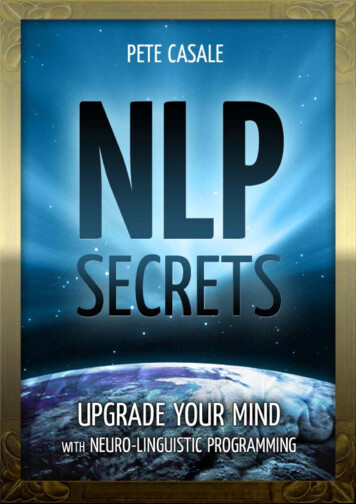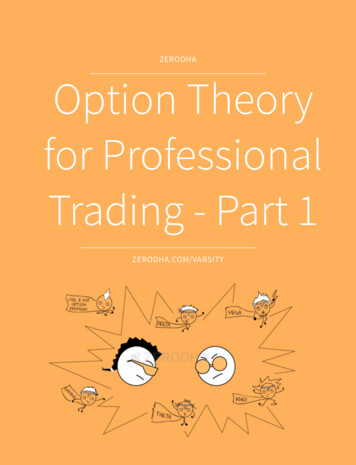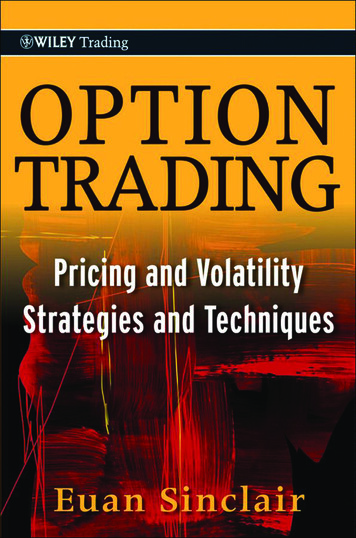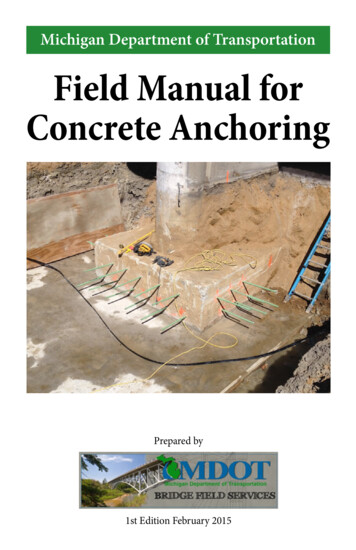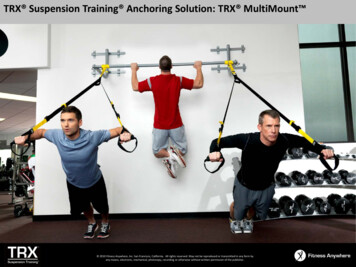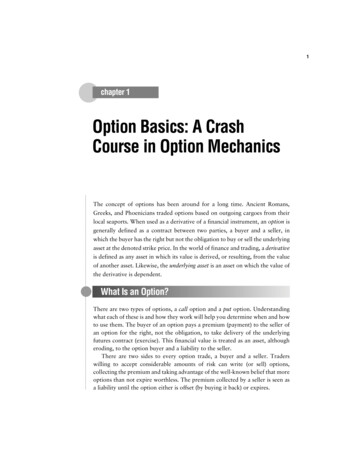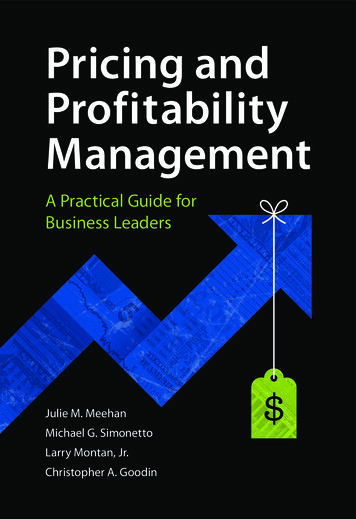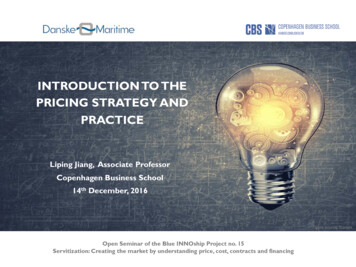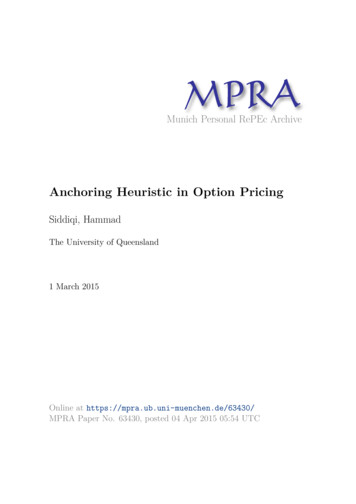
Transcription
Munich Personal RePEc ArchiveAnchoring Heuristic in Option PricingSiddiqi, HammadThe University of Queensland1 March 2015Online at https://mpra.ub.uni-muenchen.de/63430/MPRA Paper No. 63430, posted 04 Apr 2015 05:54 UTC
Anchoring Heuristic in Option Pricing1Hammad SiddiqiSchool of EconomicsThe University of Queenslandh.siddiqi@uq.edu.auThis Version: April 2015An anchoring-adjusted option pricing model is developed in which the risk of the underlying stockis used as a starting point that gets adjusted upwards to estimate call option risk. Anchoring biasimplies that such adjustments are insufficient. Black-Scholes formula is obtained with no anchoringbias. The new model provides a unified explanation for a number of option pricing puzzlesincluding the implied volatility skew, superior historical performance of covered call writing, andworse-than-expected performance of zero beta straddles. The model is consistent with recentempirical findings regarding leverage adjusted option returns, and extends easily to jump-diffusionand stochastic-volatility approaches.JEL Classification: G13, G12, G02Keywords: Anchoring, Implied Volatility Skew, Stochastic Volatility, Jump Diffusion, Covered CallWriting, Zero-Beta Straddle, Leverage Adjusted Option Returns, Behavioral Finance1I am grateful to John Quiggin, Simon Grant, Hersh Shefrin, Don Chance, Emanuel Derman, and participants ineconomic theory seminar at the University of Queensland for helpful suggestions. All errors and omissions are author’sresponsibility.A previous version of the paper was circulated with the title, “Analogy Making and the Structure of Implied VolatilitySkew”.1
Anchoring Heuristic in Option PricingOne of the major achievements in financial economics is the no-arbitrage approach of pricingoptions that does not require careful modeling of investor demand. Starting from the Black-Scholesmodel (1973), this literature has expanded in various directions and most notably, has explored theimplications of allowing for both jump diffusion and stochastic volatility. Bates (2003) reviews thisliterature and concludes that it does not adequately capture or explain the key observed features ofempirical option prices. Jackwerth (2000) presents the intriguing finding that risk aversion functionsrecovered from option prices are irreconcilable with a representative investor. Perhaps, as argued inBollen and Whaley (2004), another line of inquiry is to acknowledge the importance ofheterogeneous expectations and the impact of resulting demand pressures on option prices.In demand-based option pricing, investor risk perceptions naturally matter for option prices.A relevant question is how are such risk judgments formed? According to asset pricing theory, aninvestor is a subjective expected utility maximizer who forms his risk judgment by figuring out thecovariance of an asset’s return with his marginal utility of consumption. The investor forms suchjudgments for all available assets in the process of creating a portfolio that maximizes his expectedutility from consumption. It is reasonable to think that instead of forming such judgments inisolation for each asset, such a risk judgment is formed for a familiar asset and then extrapolated toanother closely related asset. For example, a call option and its underlying stock are closely relatedassets. As a call option is equivalent to a leveraged position in the underlying stock, it is reasonableto start with the risk of the underlying stock and add to it to form a risk judgment about a calloption.However, using the risk of the underlying stock as a starting point to arrive at the risk of acall option exposes one to the anchoring bias. Starting from the early experiments in Kahneman andTversky (1974) that show that adjustments in assessments away from some initial value are often insufficient,over 40 years of research has demonstrated the relevance of anchoring in a variety of decisioncontexts (see Furnham, A., and Boo, H. C. (2011) for a literature review). Hirshleifer (2001)considers anchoring to be an important part of “dynamic psychology-based asset pricing theory inits infancy.” (p. 1535). The role of anchoring bias has been found to be important in equity markets2
in how analysts forecast firms’ earnings (see Cen, L. Hillary F., and Wei, J. (2013)). Also, Campbell,S. D., and Sharpe, S. A., (2009) find that expert consensus forecasts of monthly economic releasesare systematically biased toward the value of previous months releases. Johnson, J., Liu, S., andSchnytzer, A. (2009) show that investors in a particular financial market (horse-race betting) areprone to the anchoring bias. Overall, anchoring appears to be a highly relevant concept for financialmarkets.Anchoring bias implies that using the underlying stock risk as a starting point for assessingcall option risk leads to an under-estimation of risk. This paper explores the implications of such abias for option pricing. It puts forward an option pricing model that incorporates anchoring in theformation of risk judgments. The new option pricing model converges to the Black-Scholes modelin the absence of anchoring bias. The new model is capable of explaining a variety of option pricingpuzzles: 1) an explanation for the implied volatility skew, 2) an explanation for the superior historicalperformance of covered call writing, 3) an explanation for the worse-than-expected historicalperformance of zero-beta-straddles, and 4) an explanation for recent empirical findings regardingleverage adjusted index option returns.Furthermore, the model predicts that average put returns (for options held to expiry) shouldbe more negative than what the Black Scholes model predicts. This is quite intriguing given theempirical findings that average put returns (for options held to expiry) are typically more negativethan what the popular option pricing models suggest (see Chambers, Foy, Liebner, & Lu (2014) andreferences therein). Also, with anchoring, average call returns are significantly smaller than BlackScholes prediction. Hence, the model also provides a potential explanation for the empirical findingsin Coval and Shumway (2001) that call returns are a lot smaller than what they should be given theirsystematic risk.There is considerable field and experimental evidence regarding the relevance of theanchoring bias for call option pricing. Market professionals with decades of experience often arguethat a call option is a surrogate for the underlying stock.2 Such opinions are surely indicative of the2As illustrative examples, see the to-Buying-the-Underlying-Security&id ding.about.com/od/stocks/a/OptionsInvest.htm3
importance of the underlying stock risk as a starting point for thinking about a call option risk, andpoint to insufficient adjustment to perceived risk, which creates room for the surrogacy argument.Furthermore, a series of laboratory experiments (see Rockenbach (2004), Siddiqi (2012), and Siddiqi(2011) show that the hypothesis that a call option is priced by equating its expected return to theexpected return from the underlying stock outperforms other pricing hypotheses. The results areconsistent with the idea that risk of the underlying stock is used as a starting point with theanchoring heuristic ensuring that adjustments to the stock risk to arrive at call risk are insufficient.Hence, expected call returns do not deviate from expected underlying stock returns as much as theyshould.The central prediction of asset pricing theory is:(0.1)Whereanddenote the (gross) return on a risky asset and the return on the risk free assetrespectively. Equation (0.1) shows that the return that a subjective expected utility maximizerexpects from a risky asset depends on his belief about the covariance of the asset’s return with hismarginal utility of consumption.According to (0.1), an investor is required to form a judgment about the covariance of anasset’s return with his marginal utility of consumption. It is reasonable to think that instead offorming such judgments in isolation for each asset, such a judgment is formed for a familiar assetand then extrapolated to another similar asset. A call option derives its existence from the underlyingstock, and their payoffs are strongly related and move together.With the above in mind, an analogy maker is defined as a subjective expected utility maximizer whouses the risk of the underlying stock as a reference point for forming risk judgments about the corresponding calloptions. That is, an analogy maker assesses call risk in comparison with the underlying stock risk. Ifone forms a judgment about call option risk in comparison with his judgment about the underlyingstock risk, then one may write:(0.2)4
Whereandare call and stock returns respectively, andis the adjustment used to arrive at calloption risk from the underlying stock risk. Almost always, assets pay more (less) when consumptionis high (less), hence, the covariance between an asset’s return and marginal utility of consumption isnegative. That is, I assume thatrisky as the underlying stock, I assume. So, in order to make a call option at least as. An analogy maker understands that a call option is aleveraged position in the underlying stock, hence is riskier. However, starting from the risk of the underlying stock, hedoes not fully adjust for the risk, so he underestimates the risk of a call option. That is,, which is the absolutevalue of risk adjustment is not large as it should be.In contrast, option pricing theory predicts that:(0.3)Whereand typically takes very large values. That is, typically. To appreciate, thedifference between (0.3) and (0.2), note that under the Black Scholes assumptions,, which iscall price elasticity w.r.t the underlying stock price. Ω takes very large values, especially for out-ofthe-money call options. That isis likely to be a far bigger negative number withcorrect risk judgment than with analogy making. Hence, a comparison of (0.2) and (0.3) indicatesthat, with analogy making, one likely remains anchored to the risk of the underlying stock whileforming risk judgments about the call option leading to underestimation of its risk.Substituting (0.2) in (0.1) leads to:(0.4)In contrast, substituting (0.3) in (0.1) under the Black Scholes assumptions yields:(0.5)and typically takes very large values. Hence, expected call return is likely to be smaller underanalogy making when compared with the Black-Scholes predictions.If analogy makers influence call prices, shouldn’t a rational arbitrageur make money at theirexpense by taking an appropriate position in the call option and the corresponding replicatingportfolio in accordance with the Black Scholes model? Such arbitraging is difficult if not impossible5
in the presence of transaction costs. Barberis and Thaler (2002) argue that the absence of “freelunch” does not imply that prices are right due to various limits to arbitrage including transactioncosts. In our context, the presence of transaction costs is likely to eliminate any “free lunch” at theexpense of analogy makers. It is worth mentioning that bid-ask spreads in ATM index options aretypically of the order of 3 to 5% of the option price, and spreads are typically 10% of the optionprice for deep OTM index options. In continuous time, no matter how small the transaction costsare, the total transaction cost of successful replication grows without bound rendering the BlackScholes argument toothless. It is well known that there is no non-trivial portfolio that replicates acall option in the presence of transaction costs in continuous time (see Soner, Shreve, and Cvitanic(1995)). In discrete time, transaction costs are bounded, however, a no-arbitrage interval is created.If analogy price lies within the interval, analogy makers cannot be arbitraged away. We show theconditions under which this happens in a binomial setting.If rational investors cannot sell options and buy replicating portfolios to make money due totransaction costs, can they at least write naked options, and make money, on average, in the long runat analogy makers’ expense? Analogy makers over-value call options (and put options via put-callparity), so rational investors should write them. In the case of an adverse price movement, an optionbuyer can simply choose not to exercise an option whereas option writing creates an obligation. Inparticular, writing options creates bankruptcy risk for option writers if such investors are creditconstrained; however, buying options does not create bankruptcy risk. It may not be possible forcredit constrained rational writers to make money even in the long-run in the presence ofbankruptcy risks at the expense of analogy makers (see Shleifer and Vishny (1997) for this argumentin a general asset pricing setting).Of course, if we move away from the framework of geometric Brownian motion to morerealistic frameworks such as jump diffusion and stochastic volatility, then a replicating portfolio doesnot even exist, eliminating the possibility of any “free-lunch” at the expense of analogy makersirrespective of transaction costs and other limits to arbitrage. This article also shows that analogymaking is complementary to the approaches developed earlier such as stochastic volatility and jumpdiffusion models. Such models specify certain dynamics for the underlying stock. The idea ofanalogy making is not wedded to a particular set of assumptions regarding the price and volatilityprocesses of the underlying stock. It can be applied to a wide variety of settings. In this article, firstwe use the setting of a geometric Brownian motion. Then, we integrate analogy making with jump
An analogy maker understands that a call option is a leveraged position in the underlying stock, hence is riskier. However, starting from the risk of the underlying stock, he does not fully adjust for the risk, so he underestimates the risk of a call option. That is, , which is the absolute value of risk adjustment is not large as it should be. In contrast, option pricing theory predicts that .
